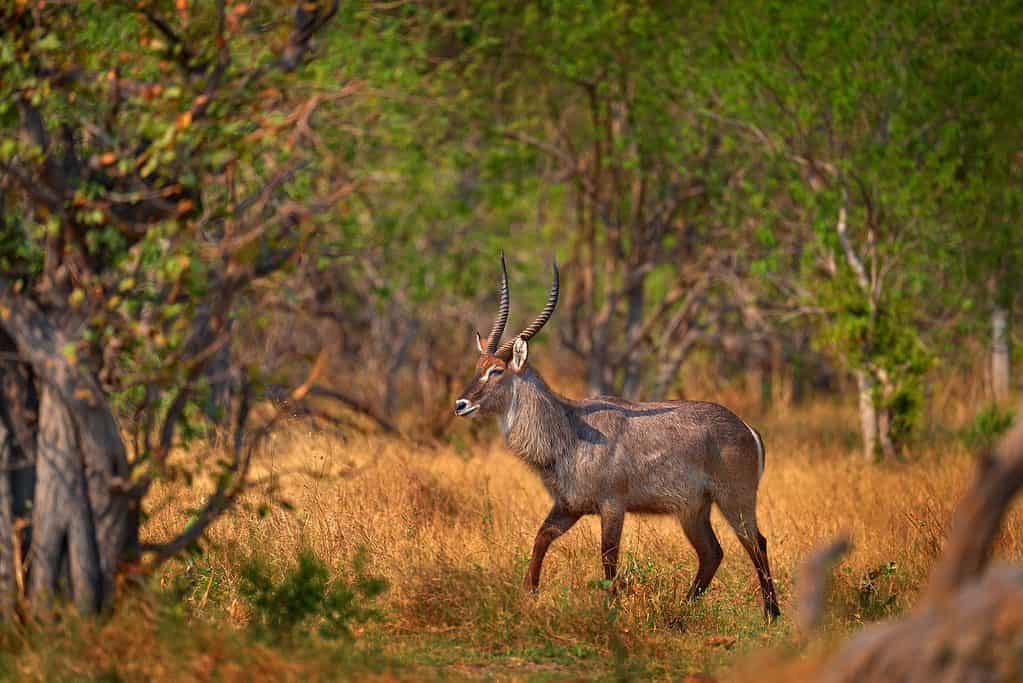Waterbuck
Kobus ellipsiprymnus
Often flee into water to escape predators
Advertisement
Waterbuck Scientific Classification
- Kingdom
- Animalia
- Phylum
- Chordata
- Class
- Mammalia
- Order
- Artiodactyla
- Family
- Bovidae
- Genus
- Kobus
- Scientific Name
- Kobus ellipsiprymnus
Read our Complete Guide to Classification of Animals.
Waterbuck Conservation Status
Waterbuck Facts
- Prey
- None
- Name Of Young
- Calf
- Group Behavior
- Herd
- Fun Fact
- Often flee into water to escape predators
- Estimated Population Size
- 200,000
- Biggest Threat
- Hunting and habitat loss
- Most Distinctive Feature
- White ring on the rump
- Distinctive Feature
- Long, spirling horns
- Gestation Period
- 7-8 months
- Habitat
- Savanna and shrubland near water
- Predators
- Lions, cheetahs, leopards, crocodiles, African wild dogs, hyenas
- Diet
- Herbivore
- Lifestyle
- Diurnal
- Favorite Food
- Grass
- Special Features
- Emit a strong smelling odor from their skin and hair
- Origin
- Africa
- Location
- Sub-Saharan Africa
Waterbuck Physical Characteristics
- Color
- Brown
- Red
- Black
- White
- Dark Brown
- Cream
- Light-Brown
- Skin Type
- Hair
- Lifespan
- Up to 30 years
- Weight
- 355-578 pounds
- Height
- 47-54 inches
- Length
- 70-93 inches
- Age of Sexual Maturity
- 7-8 months
- Venomous
- No
- Aggression
- Low
View all of the Waterbuck images!
Emit a foul-smelling oil from their skin.
Summary
The waterbuck belongs to the genus Kobus in the bovine family Bovidae. It ranks as the largest member of its genus and one of the largest antelopes found in Africa. Waterbucks are sedentary and gregarious, with most herds containing anywhere from 6 to 30 individuals. You can almost find them in close proximity to water, hence their name. They secrete an unpleasant smell from their skin and hair, making their meat rather distasteful, particularly in older animals.
5 Waterbuck Facts
- Thanks to their naturally potent smell, they don’t need to use dung or urine to mark their territory.
- Males join up with bachelor herds once they develop horns at around 7 to 9 months old.
- Females eat their calf’s afterbirth and hide their young for the first 2 to 8 weeks of life.
- A waterbuck can live 18 years in the wild and nearly 30 years in captivity.
- Scientists have developed novel repellents for protecting livestock from tsetse flies by synthesizing their odor chemicals.
Waterbuck Scientific Name
The waterbuck belongs to the genus Kobus in the bovid subfamily Reduncinae. Its generic name Kobus derives from the word Koba, a common name in various regions of Africa that they frequent. Meanwhile, its specific name ellipsiprymnus stems from the Greek words ellipes, meaning “ellipse” or “ring,” and prymnos (prumnos), meaning “hind part.” This name refers to the white ring on the rump of waterbucks. The waterbuck gets its common name due to its dependence on water and its habit of entering water to avoid predators.
Scientists distinguish them into two main subspecies varieties: the defassa waterbuck and the common or ellipsen waterbuck. These varieties further break down into 13 subspecies.
Ellipsen waterbuck:
- K. e. ellipsiprymnus
- K. e. kondensis
- K. e. pallidus
- K. e. thikae
Defassa waterbuck:
- K. e. defassa
- K. e. penricei
- K. e. crawshayi
- K. e. adolfi-friderici
- K. e. tjaderi
- K. e. harnieri
- K. e. annectens
- K. e. tschadensis
- K. e. unctuosus
Waterbuck Appearance

Thanks to their naturally potent smell, they don’t need to use dung or urine to mark their territory.
©Ondrej Prosicky/Shutterstock.com
On average, they measure 70 to 93 inches long and approximately 47 to 54 inches tall, with males measuring larger than females. Males weigh between 437 and 578 pounds, while females weigh 355 to 472 pounds. The coat varies between gray and reddish-brown, although the color tends to get darker with age. The throat appears cream-colored, the muzzle white, and the legs black. Waterbucks feature shaggy, long hair around the neck and secrete an oily substance from their skin that gives them an unpleasant odor. This odor serves a dual purpose, as it both drives away predators and helps to water-proof their bodies. Males sport long, spiral horns that curve backward and then forward. The horns can measure between 22 and 39 inches long and typically grow longer with age.
You easily tell defassa waterbucks apart from ellipsen waterbucks. Defassa waterbucks possess longer tails than ellipsen waterbucks, while ellipsen waterbucks stand taller. That said, the main difference between the two is the white ring around the rump. This ring looks hollow in ellipsen waterbucks and solid in defassa waterbucks.
Waterbuck Evolution and History
The first bovines emerged around 20 million years ago in the early half of the Miocene epoch. Unfortunately, not many waterbuck fossils have been found to determine their exact moment of emergence. The earliest fossils of similar species in the genus Kobus date back approximately 7 million years in Eurasia and 6 million years in Africa. Based on theories of ungulate dispersal, researchers believe that waterbucks first originated somewhere in eastern Africa.
Waterbuck Behavior
Waterbucks are gregarious in nature and typically live in herds of 6 to 30 individuals. Herds vary in composition, from nursery herds of mothers and calves to bachelor herds with young males and territorial bucks with their does. They can act very territorial, and territorial males will drive out juvenile males once they start to develop horns.
Waterbuck Habitat
You can find waterbucks throughout Sub-Saharan Africa. That said, the range of each subspecies differs. For example, defasssa waterbucks range between Senegal in the west and Eritrea in the east, and south throughout Ethiopia, Uganda, Tanzania, and parts of the Congo. Although some defassa waterbucks live in western Africa, these populations are relatively small and isolated. Meanwhile, the ellipsen waterbuck is confined to eastern Africa, ranging from Kenya and southern Somalia down to South Africa. They predominantly live in shrubland and savanna in close proximity to lakes, rivers, and marshes.
Waterbuck Diet
They cannot tolerate going for long periods without water and easily get dehydrated. As a result, they always stay relatively close to water but will venture into woodlands to feed. Grass makes up anywhere from 70% to 95% of their diet, particularly varieties like Rhodesian bluegrass and hippo grass. They may also eat wild rice and tree foliage, although these make up a minor part of their diet.
Waterbuck Predators and Threats
Several animals prey on adult waterbucks, including lions, cheetahs, leopards, and Nile crocodiles. Additionally, juveniles must also watch out for African wild dogs and hyenas. Waterbucks may run into cover to escape predators and sometimes enter nearby water. That said, larger males sometimes turn to attack predators using their sharp horns and powerful legs.
The primary threat to them comes not from predators but from human activities. Waterbucks are very vulnerable to habitat loss due to their sedentary nature. As a result, they can’t simply migrate to new habitats If they lose access to water or food sources. Illegal poaching also threatens waterbucks as hunters prize their horns as trophies or for sale as souvenirs. In certain areas, elevated levels of poisonous metals like cadmium and lead also threaten their populations. Finally, they can also contract various diseases, including foot-and-mouth disease, yellow fever, anthrax, and parasites such as tapeworms, ticks, and flatworms.
Reproduction and Life Cycle
While those in equatorial regions breed year-round, other populations breed seasonally. Males can confirm when a female enters oestrus by smelling her urine. Females will fight off prospective males, who show their interest by curling back their lips and rubbing their heads and horns against a female’s back. The gestation period lasts for about 7 to 8 months, after which females normally give birth to a single calf. Females eat the afterbirth to keep predators away, then take their young to secluded thickets. They may keep their young hidden away for just 2 weeks or as long as 2 months. Mothers communicate with their young using a series of bleats, grunts, and tail signals. Although calves can stand and walk just a few minutes after birth, they tend to remain with their mother for the first 8 months of life.
Juvenile males start to show horns at around 7 to 8 months old. Once this happens, territorial males drive these young bucks from the herd, who then go and join bachelor herds with other young bucks. However, young females may stay with their mothers in nursery herds or similarly join bachelor herds. Males typically mature at around 6 years old and exhibit peak territorial behavior between 6 and 9. As for females, they sexually mature between 2 and 3 years old. Waterbucks can live up to 18 years in the wild and nearly 30 years in captivity, given the right conditions.
Waterbuck Population
Presently, researchers estimate the total wild waterbuck population at around 200,000 individuals. While some populations are thriving, others appear to be on the decline. Although many live in protected areas such as national parks, a large minority remain on public lands and receive little to no protection. This makes waterbucks highly susceptible to poaching and habitat loss. Defassa waterbuck populations, in particular, are decreasing at an alarming rate because only 60% of defassa waterbucks live in protected areas. Despite these declines, the IUCN lists them as a species of Least Concern. However, the IUCN does distinguish between the two subspecies. When you consider that, the IUCN lists the ellipsen waterbuck as a species of Least Concern and the defassa waterbuck as a Near Threatened species.
Related Animals
View all 108 animals that start with WWaterbuck FAQs (Frequently Asked Questions)
Are waterbucks carnivores, herbivores, or omnivores?
Waterbucks are herbivores that primarily graze on grasses. They also eat reeds, rushes, leaves, aquatic roots and plants, and certain fruits.
Where are waterbucks found?
You can find waterbucks throughout much of Sub-Saharan Africa, particularly in southern and eastern Africa. They mostly inhabit grasslands and savanna near marshes, rivers, and lakes and occasionally venture into woodlands.
Why is it called a waterbuck?
The waterbuck gets its name due to its dependence on water and habit of hiding in water to escape from predators.
Can you eat waterbuck meat?
Waterbuck meat can taste rather unpleasant, but only if the meat comes into contact with the animal’s skin or hair. So long as you carefully remove the skin and hair while skinning, waterbuck meat is quite edible.
Thank you for reading! Have some feedback for us? Contact the AZ Animals editorial team.
Sources
- , Available here: https://seaworld.org/animals/facts/mammals/defassa-waterbuck/
- , Available here: https://www.awf.org/wildlife-conservation/waterbuck

















